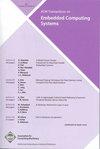Lightweight Champions of the World: Side-Channel Resistant Open Hardware for Finalists in the NIST Lightweight Cryptography Standardization Process
IF 2.8
3区 计算机科学
Q2 COMPUTER SCIENCE, HARDWARE & ARCHITECTURE
引用次数: 0
Abstract
Cryptographic competitions played a significant role in stimulating the development and release of open hardware for cryptography. The primary reason was the focus of standardization organizations and other contest organizers on transparency and fairness of hardware benchmarking, which could be achieved only with all source code made available for public scrutiny. Consequently, the number and quality of open-source hardware implementations developed during subsequent major competitions, such as AES, SHA-3, and CAESAR, have steadily increased. However, most of these implementations were still quite far from being used in future products due to the lack of countermeasures against side-channel analysis (SCA). In this paper, we discuss the first coordinated effort at developing SCA-resistant open hardware for all finalists of a cryptographic standardization process. The developed hardware is then evaluated by independent labs for information leakage and resilience to selected attacks. Our target included the ten finalists of the NIST Lightweight Cryptography Standardization Process. The authors’ contributions included formulating detailed requirements, publicizing the submissions, matching open hardware with suitable SCA-evaluation labs, developing a subset of all implementations, serving as one of the six evaluation labs, performing FPGA benchmarking of all protected and unprotected implementations, and summarizing results in the comprehensive report. Our results confirm that NIST made the right decision in selecting Ascon as a future lightweight cryptography standard. They also indicate that at least three other algorithms, Xoodyak, TinyJAMBU, and ISAP, were very strong competitors and outperformed Ascon in at least one of the evaluated performance metrics.轻量级世界冠军:NIST 轻量级密码标准化进程入围者的抗侧信道开放硬件
密码学竞赛在促进密码学开放硬件的开发和发布方面发挥了重要作用。主要原因是标准化组织和其他竞赛组织者注重硬件基准测试的透明度和公平性,而这只有在所有源代码都公开供公众审查的情况下才能实现。因此,在 AES、SHA-3 和 CAESAR 等后续大型竞赛中开发的开源硬件实现的数量和质量都稳步提高。然而,由于缺乏针对侧信道分析(SCA)的对抗措施,这些实现中的大多数离在未来产品中使用还很遥远。在本文中,我们讨论了为密码标准化进程的所有入围者开发抗 SCA 开放硬件的首次协调努力。然后,由独立实验室对所开发的硬件进行信息泄露和抵御选定攻击的能力评估。我们的目标包括 NIST 轻量级密码标准化进程的十个入围者。作者的贡献包括制定详细的要求、公布提交材料、将开放硬件与合适的 SCA 评估实验室相匹配、开发所有实现的子集、作为六个评估实验室之一、对所有受保护和未受保护的实现进行 FPGA 基准测试,以及在综合报告中总结结果。我们的研究结果证明,NIST 选择 Ascon 作为未来的轻量级密码标准是正确的。这些结果还表明,至少有另外三种算法(Xoodyak、TinyJAMBU 和 ISAP)是非常强劲的竞争对手,它们至少在一项评估的性能指标上优于 Ascon。
本文章由计算机程序翻译,如有差异,请以英文原文为准。
求助全文
约1分钟内获得全文
求助全文
来源期刊

ACM Transactions on Embedded Computing Systems
工程技术-计算机:软件工程
CiteScore
3.70
自引率
0.00%
发文量
138
审稿时长
6 months
期刊介绍:
The design of embedded computing systems, both the software and hardware, increasingly relies on sophisticated algorithms, analytical models, and methodologies. ACM Transactions on Embedded Computing Systems (TECS) aims to present the leading work relating to the analysis, design, behavior, and experience with embedded computing systems.
 求助内容:
求助内容: 应助结果提醒方式:
应助结果提醒方式:


